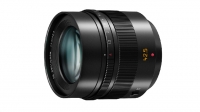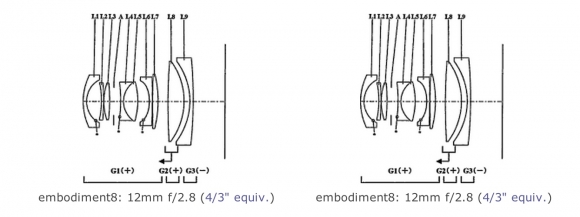Patents from Panasonic and Fujifilm show super fast wide angle lens, new hybrid AF pixel technology, respectively
posted Monday, August 11, 2014 at 4:04 PM EDT

Our friends over at Egami have been busy spotting patents from the world of digital imaging, and two of them have caught our attention. One is a Panasonic patent for a super fast 12mm f/1.2 wide angle lens for Micro Four Thirds, including a couple of other, similar lens designs. The other one is from Fujifilm and sketches a new technology that allows to use on-sensor phase detection AF pixels also as photosites.
Panasonic has filed a patent for no less than nine lens designs, each one for a 12mm wide angle lens for Micro Four Thirds. The main difference between the lens designs is their respective aperture size, and the according amount of lens elements and overall lens size. The smallest and slowest lens sports an f/2.8 aperture, 9 lens elements in 8 groups, and a length of 2.1 what appear to be inches (centimeters wouldn't make a lot of sense, but it's not explicitly stated which unit the number refers to.)

Then there are a couple of f/2 and f/1.4 designs, but the most interesting of the bunch is easily the super fast 12mm f/1.2, which is a wide angle lens design of unprecedented speed. Of course, with an aperture this wide also comes a rather complex lens design, and so this lens sports (or rather: would sport, should it ever be made) 12 lens elements in 9 groups and an overall length of 4.3 inches. As with previous super fast Micro Four Thirds lenses from Panasonic, this one looks like a candidate to bear the Leica name -- possibly the new Nocticron designation that was introduced with the 42.5mm f/1.2 lens.
The second patent that caught our attention comes from Fujifilm and is for a new on-sensor phase dection AF pixel technology. Including phase detection pixels on the camera's sensor has been a trend in the past year, and the most notable developments are Canon's Dual Pixel system introduced with the EOS 70D, and Fujifilm's latest X-Trans sensor as used in the X-E2 and X-T1, which allows for split image focusing similar to a rangefinder system.
Whereas the current X-Trans sensor uses pixels that capture only light coming on from one side of the lens, with the other half of the pixel shielded, Canon's system uses two photosites for each pixel, one for capturing the image and one for PDAF. The new Fujifilm patent works similar to the current technology used in the X-Trans sensor, but it comes with a clever twist: the shielding above the pixel can be switched from opaque to translucent by applying a current, thus allowing for the pixel to work either as a PDAF sensel or a photosite.
This way, the new system promises to reduce image quality degradation caused by the classical approach of completely shielding one half of the pixel from the incoming light. Egami notes that light transmission to the hybrid AF pixels still wouldn't be 100% with this technology, but that image quality degratation would be minimized. Of course, this design would make the whole architecture of the sensor much more complex as the circuitry for controlling the opacity of the shielding elements has to be included on top of everything else.
As always, we advise you take these patents with a grain of salt, as there's no saying as to whether any of these products will ever hit the market. But we'd absolutely love to see that 12mm f/1.2 lens, and with the progress that technology makes over time it isn't entirely impossible that we'd see Fuji's new hybrid PDAF pixel technology become a reality.
(via 43rumors, Fuji Rumors)